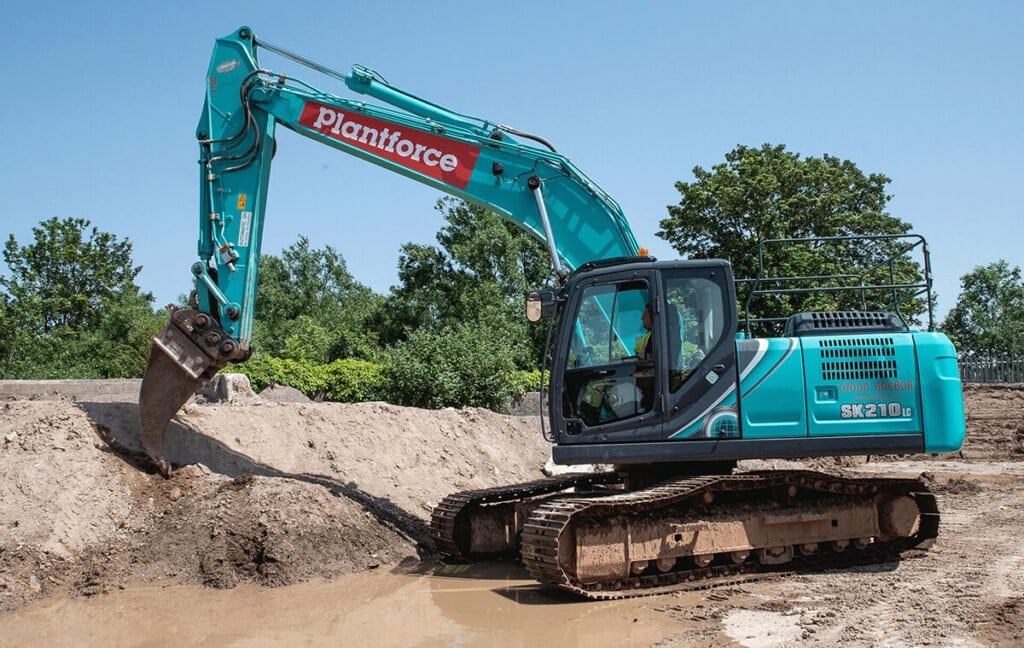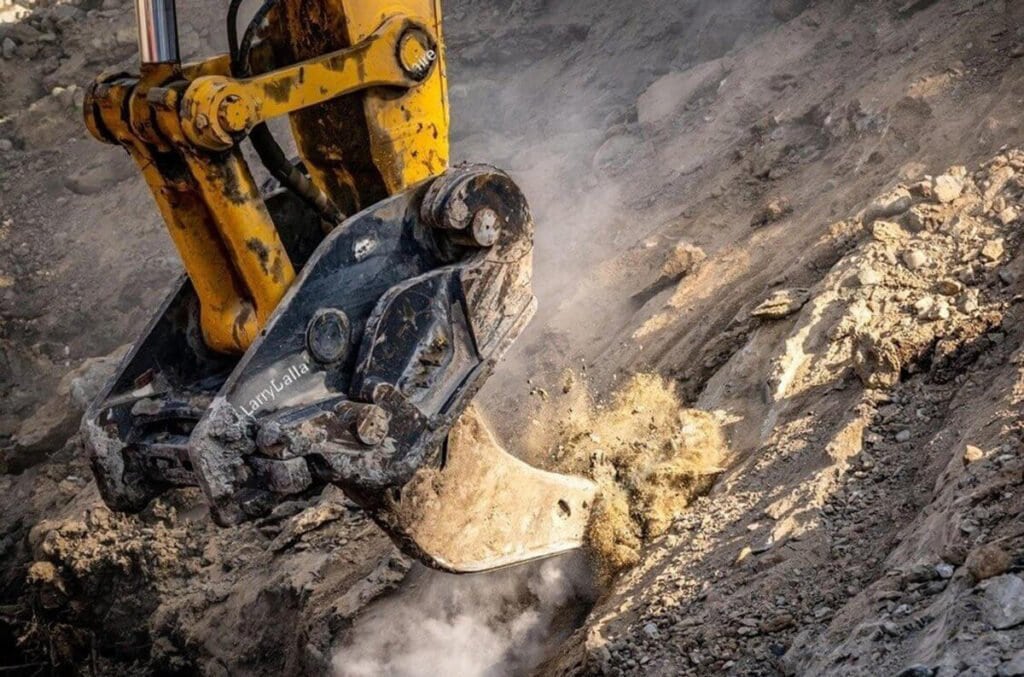When working on tough construction sites, breaking through hard ground, rocks, or frozen surfaces can slow down your project, costing you valuable time and money. You might find yourself relying on manual labor or outdated methods that are inefficient and expensive. In these situations, an excavator ripper attachment could be the game-changer you need to accelerate your progress and enhance the overall effectiveness of your excavator.
Un excavator ripper is specifically designed to help you break tough materials with ease. Whether it’s bedrock, frozen ground, or compacted clay, this powerful tool can penetrate and loosen even the hardest soils, making your work smoother and faster. By attaching it to your excavator, you can boost productivity, reduce labor costs, and finish projects on time, all while maintaining high safety standards.
In this article, we will dive deeper into what an excavator ripper is, the different types available, and how it can significantly improve your construction operations. Let’s explore how this tool can help you overcome tough digging challenges and keep your projects running efficiently.

1. What Is an Excavator Ripper?
Un excavator ripper is a large, heavy-duty attachment fitted to the back of an excavator. It features a sharp, curved blade or teeth that are designed to break, tear, or rip through solid materials such as rock, hard clay, or frozen ground. The hydraulic power of the excavator drives the ripper into the material, allowing the excavator to loosen or fragment it, making it easier to remove or excavate.
- Cómo funciona: The ripper is typically mounted on the arm or boom of the excavator, with its teeth facing the ground. When the excavator lowers the ripper into the material, the teeth penetrate and rip the surface apart, breaking it into smaller, more manageable pieces.
- Aplicaciones: Excavator rippers are commonly used in mining, road construction, foundation preparation, and even agricultural land preparation where hard ground needs to be broken up.

2. Types of Excavator Rippers
Excavator rippers come in a variety of designs and configurations, each suited to specific materials and project needs. Below, we will look at the most common types of rippers available.
2.1 Single-Shank Ripper
- Descripción: The single-shank ripper has a single, large tooth mounted on a sturdy shaft. This type is ideal for breaking through softer materials like compacted clay or medium-density soils.
- Best Use: Use the single-shank ripper for projects that involve breaking up less dense materials or for general land clearing.
- Tip: If you’re dealing with medium soil conditions, a single-shank ripper can provide enough force without overwhelming your equipment.
2.2 Multi-Shank Ripper
- Descripción: The multi-shank ripper features two or more teeth mounted on a single arm, providing more coverage and the ability to break through tougher materials like shale, rock, and frozen ground.
- Best Use: This type of ripper is ideal for large-scale roadwork or mining projects where there are varying soil conditions and a need for more aggressive ground-breaking capabilities.
- Tip: For high productivity, multi-shank rippers allow multiple points of contact with the ground, enabling faster and more efficient material removal.
2.3 Heavy-Duty Ripper
- Descripción: A heavy-duty ripper is designed for the most extreme conditions, including rock formations and hardened soils. These rippers feature reinforced teeth, usually made of hardened steel or carbide, to ensure they can handle high impact without breaking or wearing down quickly.
- Best Use: Heavy-duty rippers are used for projects where you need to break through tough bedrock or compacted material, often in mining or large civil engineering projects.
- Tip: If your work frequently involves rocky or highly compacted ground, investing in a heavy-duty ripper will increase the efficiency and longevity of your equipment.
2.4 Frozen Ground Ripper
- Descripción: The frozen ground ripper is a specialized attachment designed to break through frozen ground or permafrost. These rippers often feature an extended shank or a specially designed blade to generate additional force to penetrate ice and frozen soil.
- Best Use: Ideal for construction projects in colder climates, especially in regions where the ground can freeze over, making excavation difficult without a ripper.
- Tip: When working in extremely cold temperatures, always ensure that the ripper is designed to withstand the strain of breaking through frozen material to avoid premature wear.

3. Benefits of Using an Excavator Ripper
Using an excavator ripper provides several significant benefits for projects that require ground-breaking or material loosening. Whether you’re dealing with rocky terrain, frozen ground, or compacted soil, a ripper can increase efficiency, reduce labor, and improve safety on the job site.
3.1 Increased Efficiency
- How It Helps: The excavator ripper significantly reduces the time it takes to break up hard soil and rock. Rather than using traditional methods like blasting or manual labor, the ripper uses the excavator’s hydraulic power to quickly and effectively loosen materials.
- Tip: The increased speed of ripping allows your project to stay on schedule, saving both time and money. It’s especially useful for large construction or mining projects that need to move quickly.
3.2 Improved Precision and Control
- How It Helps: Excavator rippers are known for their precision in breaking materials. The controlled ripping action helps avoid damage to surrounding soil or structures. It’s especially important when working in tight spaces or near existing infrastructure.
- Tip: A ripper allows for a controlled and targeted approach when breaking tough materials, ensuring that you only remove the necessary material without disrupting nearby areas.
3.3 Enhanced Safety
- How It Helps: Excavator rippers reduce the need for manual labor in hazardous conditions, such as working with frozen ground or rock formations. The hydraulic system offers greater stability and control, reducing the risk of injury compared to manual digging methods.
- Tip: Always ensure that your team is properly trained to operate heavy machinery like the excavator with ripper attachment. This reduces the chance of accidents and increases overall safety on the job site.
3.4 Cost-Effectiveness
- How It Helps: While the initial investment in an excavator ripper attachment may seem costly, the benefits far outweigh the expenses. The ripper reduces labor costs, enhances productivity, and reduces downtime, making it a cost-effective solution for many projects.
- Tip: For projects that require frequent ground-breaking, investing in a high-quality ripper attachment is more cost-effective in the long run, as it eliminates the need for external services or manual labor.

4. Key Specifications to Consider When Choosing an Excavator Ripper
Selecting the right excavator ripper for your project requires careful consideration of several factors to ensure the tool matches your needs and conditions. Below are key specifications to consider when making your choice.
4.1 Ripper Tooth Material and Durability
- Descripción: The material of the ripper’s teeth will determine its ability to handle tough materials. Teeth made from hardened steel or carbide are designed to endure high levels of stress and abrasion, especially when dealing with rocky or dense soil.
- Tip: Choose a ripper with teeth made from high-quality materials if you’re working with very hard or abrasive surfaces. This will extend the lifespan of the attachment and improve efficiency.
4.2 Ripper Shank Length
- Descripción: The shank length of the ripper determines how deep it can penetrate into the ground. For deep material breaking, longer shanks are necessary. For shallow tasks, a shorter shank may suffice.
- Tip: Always match the shank length with the depth of the material you need to break. Longer shanks are essential for deeper excavation or when working with layered materials.
4.3 Hydraulic Compatibility
- Descripción: Excavator rippers operate through the hydraulic system of the excavator. It’s important to ensure that the ripper is compatible with the hydraulic flow and pressure specifications of your excavator.
- Tip: Check your excavator’s specifications to ensure the ripper is compatible with the hydraulic system. Using the wrong combination can lead to inefficient operation and potential damage to both the ripper and the excavator.
4.4 Ripper Teeth Configuration
- Descripción: The number of teeth and their arrangement will affect the ripper’s effectiveness in different materials. Single-tooth rippers are typically used for softer materials, while multi-teeth configurations are used for harder ground.
- Tip: Choose a ripper with the appropriate number of teeth for your material. If you’re working with extremely tough ground, opt for a multi-shank ripper for better coverage and more effective soil disruption.

5. How to Maintain Your Excavator Ripper
Proper maintenance of your excavator ripper is essential to ensure it remains in good working condition and provides reliable performance over time. Below are some best practices to keep your ripper working efficiently.
5.1 Regular Inspections
- Descripción: Inspect the ripper regularly for any signs of wear, cracks, or loose bolts. Check the teeth and shank for any damage, and replace worn-out teeth promptly to avoid damage to the attachment.
- Tip: Regularly checking the condition of the ripper and its components will help you catch any potential issues before they become serious problems.
5.2 Cleaning After Use
- Descripción: After each use, clean the ripper to remove dirt, soil, and other debris that may accumulate during operation. Cleaning also helps prevent material buildup, which could interfere with the ripper’s performance.
- Tip: A clean ripper ensures smoother operation and reduces the risk of clogging or rust formation. Always use a pressure washer to remove stubborn materials from the teeth and shank.
5.3 Lubrication
- Descripción: Lubricate the moving parts of the ripper, especially the teeth and shank, to minimize friction and prevent wear. This will help extend the ripper’s lifespan and maintain its efficiency.
- Tip: Follow the manufacturer’s recommendations for lubrication intervals and the type of grease to use. Proper lubrication is key to maintaining smooth operation.

Conclusion: Why You Should Invest in an Excavator Ripper
An excavator ripper is an invaluable tool for construction, mining, and other heavy-duty projects requiring tough ground-breaking capabilities. By choosing the right ripper for your project, maintaining it properly, and ensuring it is compatible with your excavator, you can significantly enhance productivity and efficiency on your job site.
If you are looking for high-quality excavator rippers and other attachments, HIOSEN offers reliable solutions tailored to your needs. With our extensive experience and commitment to quality, we can help you find the perfect equipment to get your projects done faster and more efficiently. Contáctanos hoy to learn more about our range of used machinery and how we can support your operations.